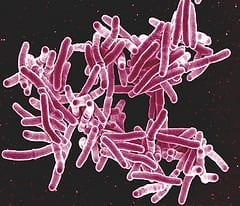
RESEARCHERS FIND LOW COST DRUG WIPES OUT DRUG RESISTANT TB, BUT WORRY IT MAY NOT REACH PATIENTS IN NEED
An off-patent anti-inflammatory drug that costs around two cents for a daily dose in developing countries has been found by researchers at Weill Cornell Medical College to kill both replicating and non-replicating drug resistant tuberculosis in the laboratory — a feat few currently approved TB drugs can do, and resistance to those is spreading.
Their findings, published online by the journal PNAS, point to a potential new therapy for the more than 500,000 people worldwide whose TB has become resistant to standard drug treatments. But the researchers worry that the effective drug, oxyphenbutazone, may never be tested in TB clinical trials.
Weill Cornell’s Dr. Carl Nathan and his research team found what they call the “completely surprising” ability of oxyphenbutazone to kill drug resistant TB after testing thousands of approved drugs against the bacteria. This repurposing of agents already on the market can lead to quicker testing for new uses.
“This agent might help save lives if there was a way to test it in TB patients,” says Dr. Nathan. Oxyphenbutazone went on the market as a patented drug for arthritis-like pain in the early 1950s, and lost its patent and market dominance by the 1970s.
“It is difficult today to launch clinical studies on a medication that is so outdated in the United States, that it is mainly used here in veterinary medicine to ease pain,” says the study’s senior author, Dr. Nathan, chairman of the Department of Microbiology and Immunology, the R.A. Rees Pritchett Professor of Microbiology, and the director of The Abby and Howard Milstein Program in the Chemical Biology of Infectious Disease at Weill Cornell. “No drug firm will pay for clinical trials if they don’t expect to make a profit on the agent. And that would be the case for an off-patent drug that people can buy over the counter for pain in most of the world.”
He adds that oxyphenbutazone, best known under the trademark name of Tandearil, does have some established toxicities, “and is not a drug you should take for aches and pains if a safer alternative is available.” But the drug’s major toxicities appear to be less frequent than the major side-effects of the drug regimens that are currently used to treat TB, he says.
TREATING THE TB THAT HIDES
Mycobacterium tuberculosis is unusual among disease-causing bacteria in that it naturally infects just humans. One-third of the world’s population is infected with TB, but the bacteria typically remain dormant in a person with a healthy immune system.
Nonetheless, TB becomes active in enough people that it is the leading cause of death in humans from a bacterial infection. It is difficult to treat, and the bacteria can become resistant to therapy. TB treatment in a drug-sensitive patient takes six months, using a combination of agents. If the TB is sensitive to these first-line agents and the therapy is completed with full-strength, non-counterfeit drugs, up to 95 percent of patients can be cured.
However, if a patient’s TB becomes resistant to these drugs, second-line agents are administered every day for two years or more. “These second-line drugs are often toxic and expensive, and are not readily available in developing countries, where most of the infections occur,” Dr. Nathan says. Mortality in drug resistant TB patients can be as high as 80 percent.
A major issue in treating TB is that the bacteria can “hide out” in the body in a non-replicating form, even when a TB patient is undergoing treatment.
via Weill Cornell Medical College
The Latest Streaming News: Drug-resistant tuberculosis updated minute-by-minute
Bookmark this page and come back often
Latest NEWS
Latest VIDEO








